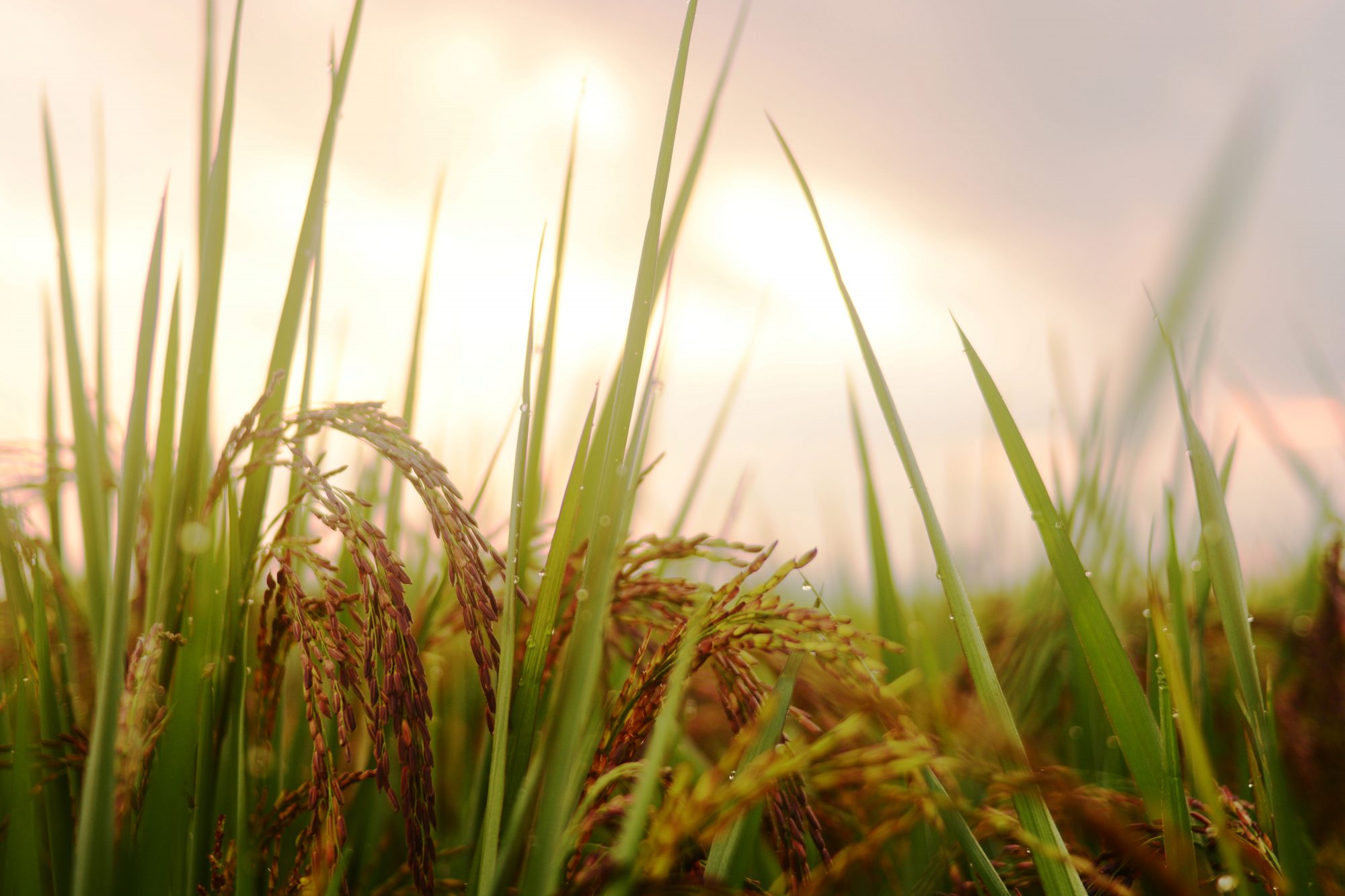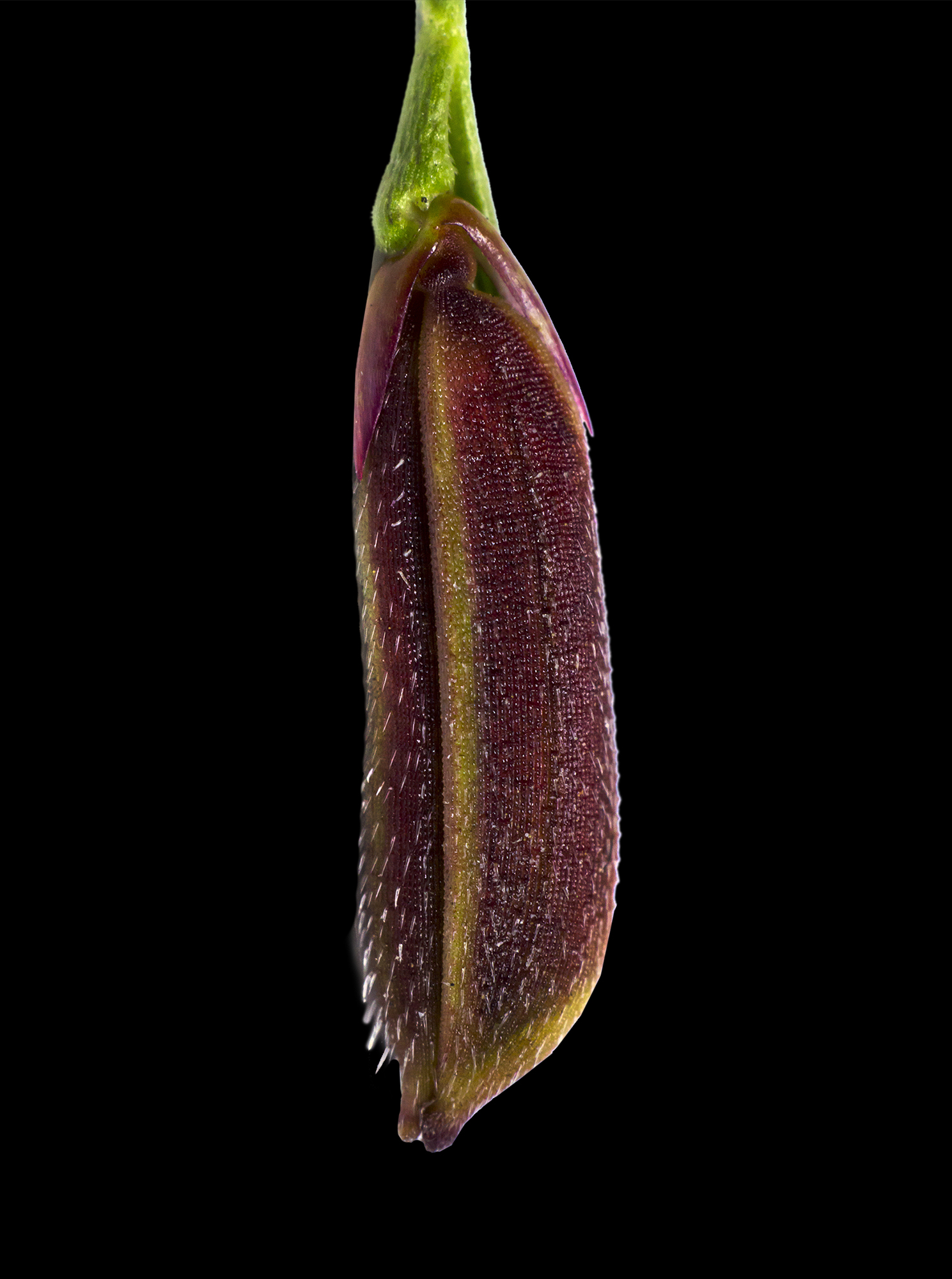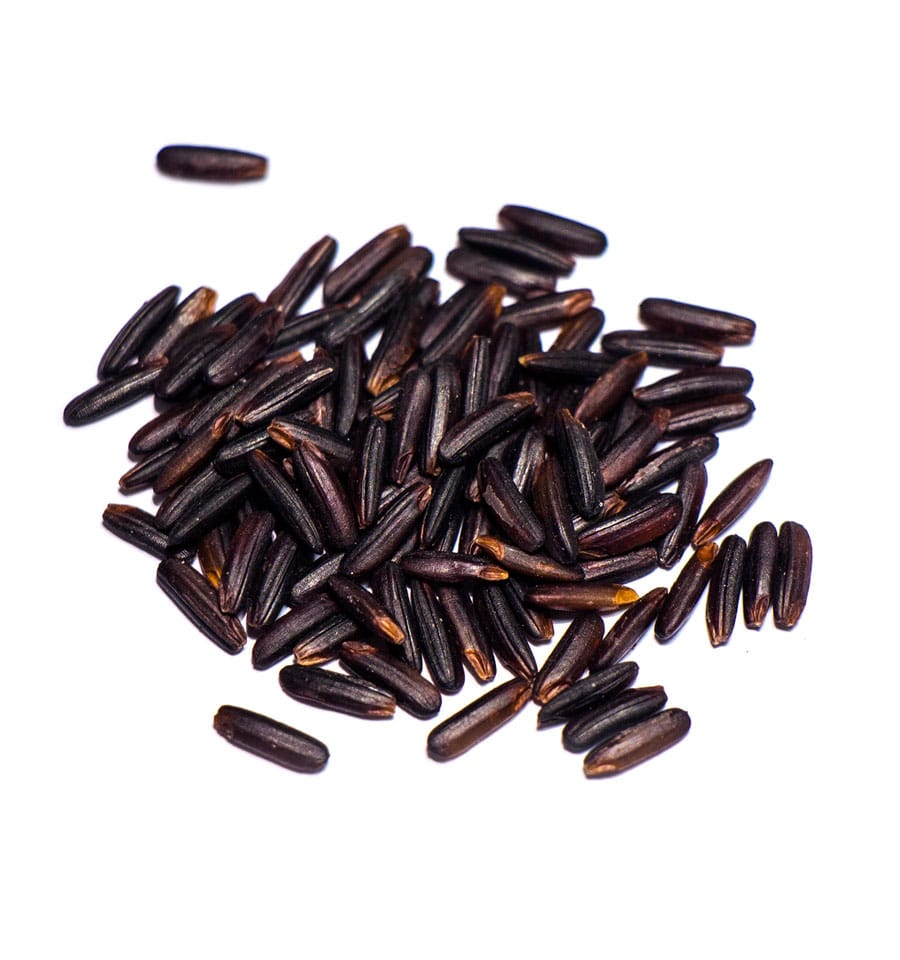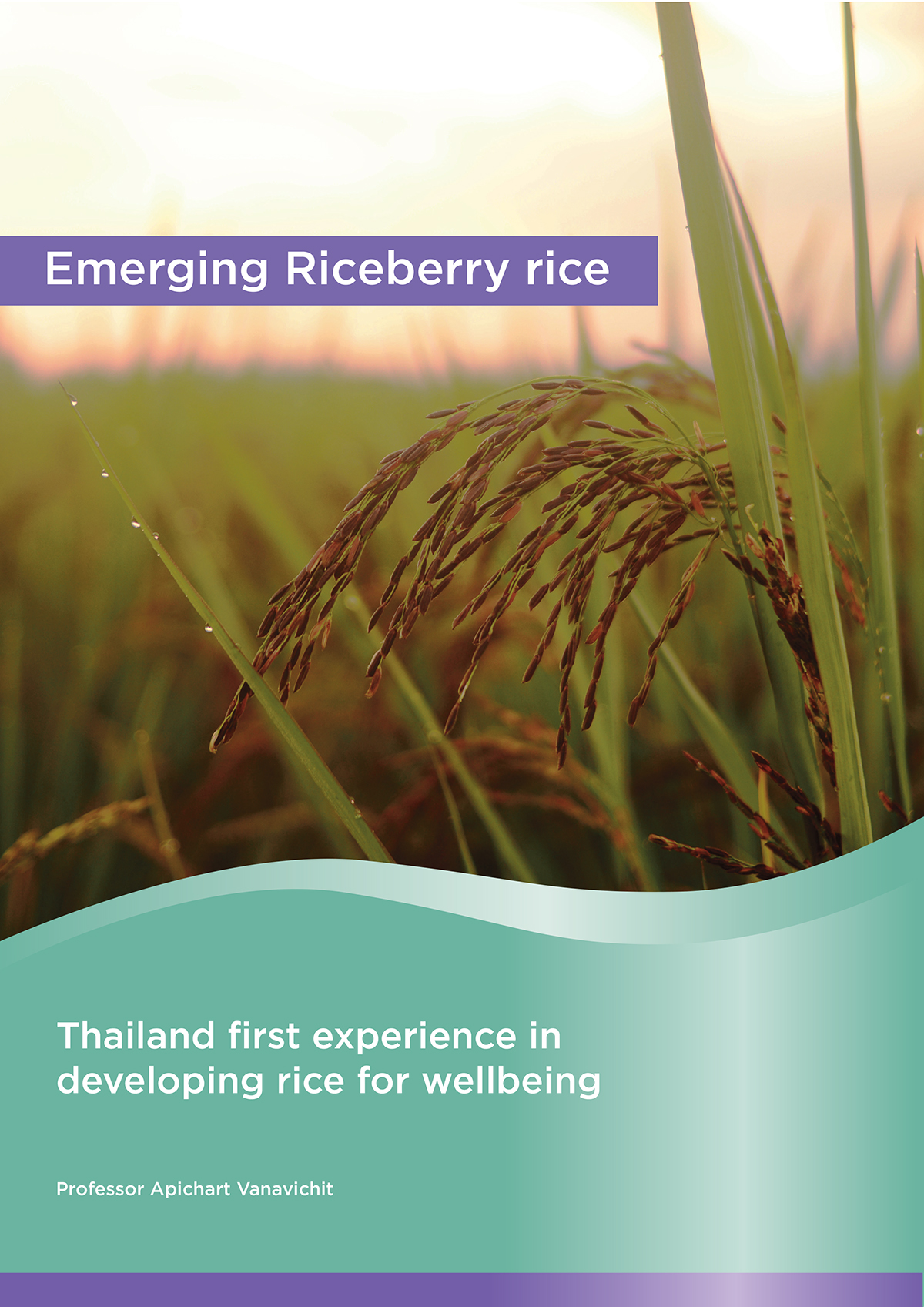Developing whole grain rice for consumer wellbeing and supporting environmentally friendly farming practices are our major goals of new super nutrient rice varieties in Thailand
The palatability of whole-grain rice is the most sensitive aspect of the art and science of breeding for better whole grain rice. Soft, aromatic, palatability, and nutrients are keys to breaking through the health-conscious marketplace. Anthocyanin-rich rice provides not only high antioxidants but also distinctive appearance and recognition. Also, traditional purple rice varieties are considered exotic and the most palatable blend of perfect fragrance, eating quality, and super-nutrient.

In ancient times, purple rice is used for making varieties of sweet dishes as spiritual foods to pay respect to gods and spirits. In China, the world-renowned purple rice was used to cook special dishes for the emperor called “Forbidden Rice”. Purple rice has been left untouched by rice breeders for the lack of economic importance. That help explain why purple rice varieties have become the richest biodiversity on high nutrition and play pivotal roles in breeding super-nutrient rice in modern time.
Today marks a decade of the best known Riceberry rice as the first modernized purple rice with super-nutrient and the greatest after-taste of whole grain rice. As the outcome of a cross between the world-renown Thai Jasmine rice and purple Jao Hom Nin (JHN), Riceberry rice is a long slender, deep purple grain with a non-sticky and distinctive aroma. So far, Riceberry rice has successfully convinced consumers to change their preference from white to whole grain without guilty and embracing whole-grain pigmented rice’s nutritional benefits. Consuming whole grain can provide a sustainable solution to lower the incidence of non-communicable diseases (NCDs) in modern lifestyles.
Rice for wellbeing defined
Rice is a primary energy food that provides approximately 50% of daily energy needs for half of the world population. In most cases, overconsumption of refined high caloric foods is the major cause of obesity and NCDs. Rice for wellbeing is confined within the functional properties of starch, dietary fibre, prebiotic, antioxidant, nutrients, and micronutrients that ameliorate the risk of NCDs. In comparison, the average available carbohydrate of the whole grain is lower than the polished rice with 15-20% extra dietary fibre and combined with rich antioxidants in a variety of pigmented rice. By such definitions, the particular whole grain rice may fit the model of rice for wellbeing:
Balancing between the content of nutrients and calories:
Providing a good balance in caloric content with ample dietary fibre, nutrients, and micronutrients such that consumers can optimise their daily caloric intake (DCI) within the recommended DCI of 2,000~2,500 kcal (male) and 1,800~2,000 kcal (female). The caloric content of three meals of white rice adds in 40% of your DCI. So consuming whole grain rice can provide you with more nutrients for the same caloric intake.
Providing fullness feeling and prolonging hunger:
In reality, most people can’t stay within the recommended DCI because sugar and most rapid digestible starch make you feel hungry quickly. The key to prolonging hunger is to consume low glycaemic index carbohydrates containing high dietary fibre.
Supporting microbiome:
Most gastrointestinal tracts host wide varieties of peculiar microbes which help support human wellbeing by stimulating the immune system. Because of strong acidity in a gastrointestinal system, successful microbiota must stay alive by symbiosis with a specific substrate of foods, called prebiotic. Whole grain rice contains specific prebiotic substrates for such microbiota to grow, such as dietary fibre and oligo-saccharides.
Being free of pesticides and heavy metals:
Current rice production requires high production inputs such as chemical herbicides, fertilizers, and pesticides that may contain carcinogenic and toxic residues, such as Cadmium (Cd) and Arsenic (As). In addition, some paddy fields may naturally be accumulated As. Therefore, organic, and sufficient rice practices are ideal for the production of rice for wellbeing. Growing only genetically improved rice varieties for pest resistance and tolerance to abiotic stresses are recommended.

Mining nutritional values from Riceberry rice bran
The most valuable part of whole-grain pigmented rice lies within the bran and germ organs. This is where most of the chemoprotective substances are deposited. Additionally, Riceberry rice imparts distinctive fragrance during cooking and stay-on after cooked. The aromatic compound is stable over time in brown rice. This aromatic compound was chemically characterised as p-hydroxyphenylbutan-2-one. The aromatic compound is stable during and after ultrapasteurization (Kullananant et al., 2020). In fact, the p-hydroxyphenylbutan-2-one (pHPB) is also called Rasberry ketone as it was firstly identified in Raspberry (Borejsza- Wysocki and Hrazdina, 1994).
As thin cell layers wrapping around the endosperm called bran has become the target of biochemical mining, more biologically active compounds have been discovered in purple rice. Riceberry bran is rich in dietary fibre, proteins, fatty acids, phytosterols, vitamins, minerals, antioxidants, anthocyanin, and polyphenols. The extraction of 80 g of defatted Riceberry bran yielded three major fractions, protein (14.98 g), phenolic compounds (226.84 mg gallic acid equivalent (GAE), and cyanidin-3- glucoside anthocyanin (3.25 mg) (Jangmesin et al., 2017). Vitamins. Furthermore, vitamins B1, B2, B3, and B9 (folate) were also found in high amounts, particularly, in dark purple Riceberry.
Chemoprotective compounds
Riceberry rice bran was solvent-extracted with hexane, dichloromethane, and methanol to uncover chemoprotective compounds. The methanolic extract yield the highest antioxidant activities which yielded 79 metabolites, including nine simple phenolic compounds. and four flavonoids. The major phenolic and flavonoid were 4-vinylguaiacol and apigen (Suttiaraporn et al., 2016). Among varieties of phenolic compounds, protocatechuic acid exhibited the highest contribution to the antioxidant activities while gamma-oryzanol was the lowest (Peanparkdee et al., 2018). Such flavones as apigenin, phytosterols, gramisterol, and triterpene lupeol are bioactive compounds from Riceberry rice bran (Leardkamolkarn et al., 2011; Suttiarporn et al., 2015; Somintara et al., 2016). In general, all chemoprotective compounds such as polyphenol, tannin, and catechin were 3~10 times that found in normal brown rice.
Natural pigments
Riceberry rice bran contains different flavonoid pigments ranging from light brown (leucoanthocyanidin and proanthocyanidin), red (cyanidin), brick red (peonidin), to navy blue (delphinidin) in various forms and rations. Anthocyanins extracted from deep purple Riceberry rice consisted mainly of cyanidin-3- glucoside (C3G), peonidin-3-glucoside (P3G), and delphinidin-3-glucoside (D3G). These water-soluble extracts impacted several bioactive functions, including antioxidant, anti- hyperglycemia, anti-lipidemia, anti-glycation, and anti-inflammatory activities (Arunahong et al., 2020). Riceberry bran accumulates beta- carotene and lutein up to 185 mg/100g and 224 mg/100g, respectively, such carotenoids are not normally found in any white rice.
Nutritional benefits of antinutritive factors
Anti-nutritive compounds were found in several plant spp., such as phytate, oxalate, polyphenol, lectins, tannins, saponins, amylase inhibitors, and protease inhibitors. Some of these compounds have functioned as insect deterrents. Riceberry rice contains various forms and content of polyphenol, tannin, and phytate. In high concentration, anti-nutritive compounds slow down particular nutrient absorption causing growth reduction, for example, effects of phytate on phosphorous and iron bioavailability. At low density, anti-nutritive compounds can reduce post-prandial blood glucose and insulin response, resulting in lowering glycemic indexes in starchy foods (Gemede and Ratta, 2014). Anthocyanins from Riceberry can inhibit calcium oxalate monohydrate growth and aggregation that could prevent kidney stone formation in vitro (Knawsuk et al., 2018).
Bioactive protein hydrolysate from Riceberry
Protein hydrolysate extracted from defatted Riceberry bran consisting of albumin, globulin, prolamin, and glutelin exhibited high antioxidant activities with DPPH IC50 at 0.052 mg/ml and FRAP IC50 at 2.27 mg/ml. Glutamic acid was present at the highest concentration in the hydrolysate (Jangmesin et al., 2017).
Developing Riceberry-based therapeutic products against NCDs
Metabolic syndrome (MetS) signifies the onset of weight gain and NCDs. Evidence linking flavonoid-rich foods with a low risk of NCDs were reported (Neri-Numa et al., 2020).
Obesity
Obesity is characterised by increased fat-cell size and number initiated by insulin resistance. One study suggested Riceberry rice bran extract inhibited adipocyte formation and proliferation (Kongthitilerd et al., 2020).
Anthocyanins also play important roles in binding primary and secondary bile acids, reducing the solubility of cholesterol in artificial micelles, and suppressing the cholesterol uptake into Caco-2 cells in a concentration-dependent manner (Chamnansilpha et al., 2020).

Roles in Type II diabetes (T2D)
T2D is initiated by degeneration of pancreatic B cells causing insulin resistance and hyper- glycemia by preventing liver cells from converting unused serum glucose into glycogen. The first clinical study linking the benefits of Riceberry bran was undertaken with experimentally-induced diabetic rats (Prangthip et al., 2013). Fed with Riceberry bran at 1.5%~9% body weight for one month, the induced T2D rats had ameliorated insulin tolerance, hyperglycemia, apoptosis of B cells, and significantly improved functions of liver and pancreas (Posuwan et al., 2013).
The Glycemic index is the most important indicator of how carbohydrate affects post- prandial blood glucose. Riceberry rice bran contributed to high dietary fibre and other inhibitory factors that can help reduce the glycemic index of bakery products. In another study, Riceberry bran was used as an oil absorber in puffed cracker industries (Jiamjariyatam, 2019). Bread supplemented with Riceberry rice bran can lower the glycemic response and increase antioxidants compared to white-rice supplemented bread (Arunahong et al., 2020). In another study using whole grain flour from anthocyanin-rich Riceberry rice and Thai Jasmine rice in a cohort of 16 healthy participants, the gluten-free bread had significantly lowered the post-prandial blood glucose (PPBG), post-prandial blood insulin (PPBI), and enhanced the post-prandial ferric- reducing ability of plasma (FRAP)(Chusak et al., 2020).
Enzyme inhibitors against alpha-amylase, alpha-glucosidase, and angiotensin-converting enzyme (ACE) play important roles in releasing rapidly available glucose from carbohydrate-rich foods causing a post-prandial blood glucose spike. These enzyme inhibitors were identified in the Riceberry rice bran protein hydrolysates fraction (Uraipong and Chao, 2015). Glutelin- associated peptides showed the strongest beta-glucosidase inhibitor. The specific peptide can replace Acarbose, a medicine used to delay carbohydrate digestion in patients with diabetes (Uraipong and Chao, 2015). Phytate, another important antinutritive factor found in whole grain cereals, has been shown to have interesting twists in diabetes derived from the Riceberry rice bran protein hydrolysate. On one hand, low density of phytate reduced post- prandial blood glucose and insulin response in starchy foods. On the other hand, at higher density, phytate blocked absorption of phosphorous and iron causing micronutrient deficiency (Gemede and Ratta, 2014).
Pregerminated whole grain rice is quite popular among health-conscious consumers because it helps soften cooked whole grain rice. The first report showed pregerminated Riceberry rice enriched non-digestible starch, phenolic metabolites, and probiotic index (PI) causing reduced GI from 72 to 61 in vitro (Owolabi et al., 2020). The anthocyanin-rich yoghurt developed from Riceberry rice bran reduced post-prandial blood glucose and improved plasma antioxidant capacity in healthy volunteers (Anuyahong et al., 2020). In addition, high fibre pudding made from Riceberry rice was developed for the elderly who often suffers from both swallow difficulty (dysphagia) and diabetes (Sittireung et al., 2019). Therefore, such innovative foods from Riceberry rice and bran may help consumers control diabetes, obesity, and NCDs.
Riceberry bran oil: Roles in cardiovascular diseases
Although Riceberry rice bran contains only 8-10% oil by normal hydraulic-pressed practice, it is a significant source of wide varieties of lipid-soluble antioxidants such as gramisterol, gamma oryzanol, vitamin E, beta-carotene, and lutein. Hyperlipidemia is a major risk factor for heart disease and an advanced symptom of many metabolic disorders, including diabetes and obesity. Studies have demonstrated that streptozotocin-induced diabetic rats fed with Riceberry bran oil (RBBO) supplements have improved the levels of high-density lipoprotein (HDL or good cholesterol) over the low-density lipoprotein (LDL or bad cholesterol) (Prangthip et al., 2013). After 12 weeks, the malondialdehyde was decreased while the superoxide dismutase, catalase, glutathione peroxidase, coenzyme Q10 and Oxygen Radical Absorbance Capacity (ORAC) levels were restored in RBBO-treated diabetic rats (Posuwan et al., 2013). Cold-pressed Riceberry rice bran oil has become an excellent delivery system for multi-strains of probiotics to proliferate in the human gut environment and lower the risk of cardiovascular diseases (Chumphon et al., 2021). The health benefits of such synbiotic products are waiting to be tested in vivo.
Prevention of cancer
In addition to cancer prevention, chemo-protective compounds have become a subject of research to discover new functional roles in preventing NCDs. Chemical extraction of Riceberry bran uncovers unusual chemo- protective compounds, including beta-carotene and lutein, which are absent in white rice. Apigenin, phytosterols, and triterpenes lupeol confer chemoprotective properties in human cell lines, including Caco-2 (colon cancer) and MCF-7 (breast cancer), with the most notable effects being on the HL-60 (Leukemia) (Leardkamolkarn et al., 2011). Furthermore, gramisterol was specifically shown to prevent acute myelogenous leukaemia (AML) and protect the dysfunctional immune system of leukemic mice (Somintara et al., 2016).
The mechanism of blood vessel formation by angiogenesis is an important step in determining the growth and spread of cancer cells. Anthocyanins cyanidin and peonidin showed protective effects against angiogenesis induced by vascular endothelial growth factor (VEGF) and affected the proliferation and migration of cancer cells (Tanaka et al., 2012).
For more information on the development of rice for wellbeing please click the accompanying eBook.


